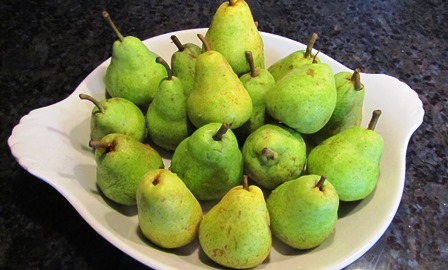Fire Blight Can Ravage a Pear Tree or Take Down an Orchard
I’ve discovered limb tips, fruit, and blossoms blackened by fire blight in my Bartlett pear tree. That means dealing with the disease quickly or losing tree.
While there are dozens of other types of fruit trees on the farmette, there are no other pear trees. Sadly, this one is in bad shape because of a widespread infection by the bacteria Erwinia amylovora.
The blight started last summer and, despite spraying to control it, the disease has overwintered in the bark of the tree to reappear with the emergence of blossoms this year. Disease spread is helped along by the bees.
Fire blight’s vicious cycle and must be broken if the tree is to survive. The life cycle of blight can be seen at a glance at http://nysipm.cornell.edu/factsheets/treefruit/diseases/fb/fb_cycle.gif
Treatment starts with a vigorous pruning of the affected limbs. That means cutting back twelve inches from the site of the blackened area of fire blight. The disease is highly contagious, so the cuttings must not be recycled or composted. Burning them is recommended.
Also, minimizing the amount of tree blight inoculum in the orchard is important as this disease can also spread to other pear trees, apples, quince, raspberries, and fire-thorn bushes. Cornell recommends a regular spraying program using an appropriate bacteriocide to save fruit trees infected with fire blight.
The saddest thing of all for me is that the tree was once beautiful and healthy and (even now) is loaded with fruit. I hate to think of not being able to save this lovely pear tree. Since most pear cultivars are susceptible to fire blight, it might make sense for me to plant a Seckel Pear tree since it is less susceptible to this highly contagious disease that can destroy a single tree or ravage the entire orchard.
Forcing Blooms of Branches and Bulbs
If spring hasn’t arrived in your corner of the world, be of good cheer. You can effectively bring spring indoors by forcing bulbs to open or branches of spring-flowering trees to bloom in your home.
Trees that bloom in the spring need to have sufficient chilling hours before they break their dormancy, so it’s advisable to try forcing blooms during the months of January and February rather than in December.
Choose half-inch branches of golden forsythia, pussy willow, coral quince, or almost any fruit tree. Using sharp pruning shears or a knife, cut diagonally above a bud so that you have two- or three-feet long branches to force into bloom.
After bringing the branches indoors, you’ll want to cut slits into the bottom of the branches to ensure water is more easily absorbed. Put the branches in a container of water. Every other day, trim the stems and change the water. Bring in new branches every few days to ensure continuous blooms.
Nothing beats the paper-white narcissus or buttery yellow daffodil for brightening a kitchen on a dreary winter’s day. Choose healthy a bulb (or bulbs) free of bruising, cuts, of infection. In a bowl, glass, or saucer, place glass marbles or pebbles. Add water.
Position the bulb or bulbs securely so that the roots can grow down into the water, but the bulb remains out of the water sitting on top of the marbles or pebbles. Ensure that the water level beneath the bulb remains constant and add more water as necessary.
Paper-white narcissus, purple hyacinth, and certain daffodils add not only spring color to an indoor environment but also a lovely sweet scent wherever they are placed.
 Facebook
Facebook Goodreads
Goodreads LinkedIn
LinkedIn Meera Lester
Meera Lester Twitter
Twitter








